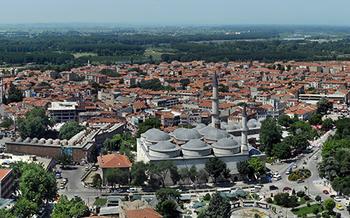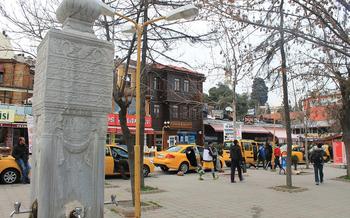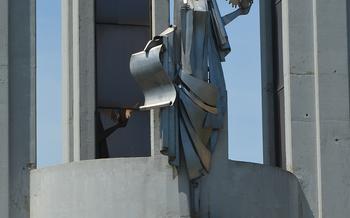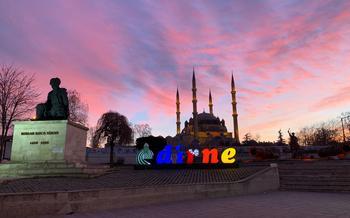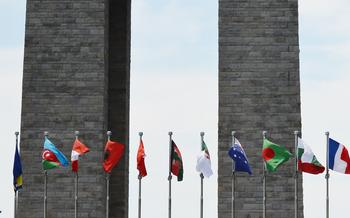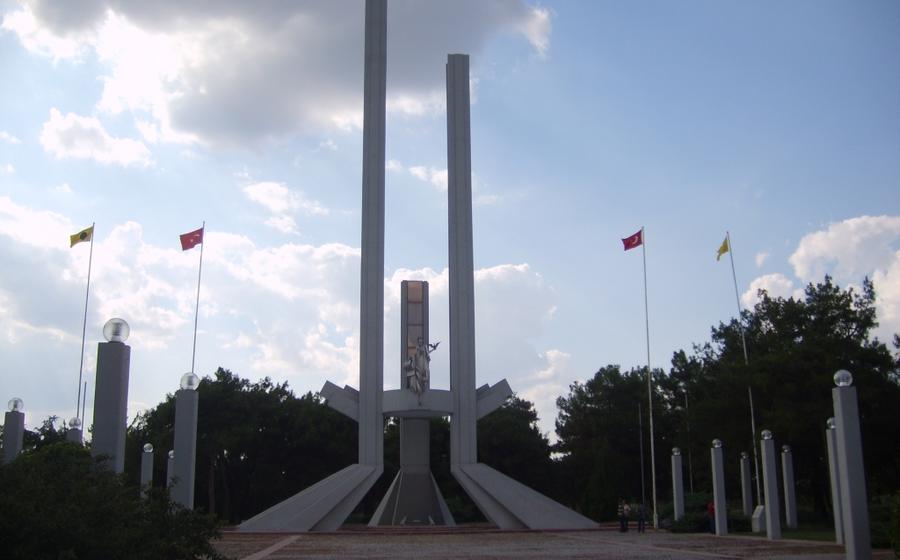
Lozan Anıtı (Lausanne Monument)
- About the Lozan Anıtı (Lausanne Monument)
- The History of the Treaty of Lausanne
- Exploring the Monument's Surroundings
- Transportation to the Lozan Anıtı (Lausanne Monument)
- Museum Exhibits and Displays
- The Lausanne Conference and its Impact
- Photography and Videography
- Souvenirs and Memorabilia
- Planning Your Visit
- Language Considerations
- Respecting the Monument and its Significance
- Safety Precautions
- Local Customs and Traditions
- Insider Tip: Uncover the Hidden Gems of Edirne
About the Lozan Anıtı (Lausanne Monument)
The Lozan Anıtı (Lausanne Monument) stands as a testament to the historic Treaty of Lausanne, which shaped the fate of Turkey and the broader region in the aftermath of World War I. Located in the vibrant city of Edirne, the monument commemorates the pivotal negotiations that took place in Lausanne, Switzerland, from November 1922 to July 192The imposing structure, designed by renowned sculptor Hüseyin Gezer, captures the essence of this transformative period in Turkey's history.
The monument's architectural features are a blend of traditional Turkish motifs and modern design. Its towering columns, intricate carvings, and symbolic reliefs evoke a sense of grandeur and significance. The centerpiece of the monument is an impressive bronze sculpture depicting Mustafa Kemal Atatürk, the father of modern Turkey, signing the historic treaty. This majestic effigy stands as a symbol of Turkey's emergence as a sovereign nation and its determination to shape its own destiny.
The Treaty of Lausanne, signed on July 24, 1923, marked a turning point in Turkey's history. It established the modern borders of Turkey, recognizing its independence and sovereignty after the tumultuous years of the Ottoman Empire's decline and World War I. The treaty also addressed various territorial disputes, including the status of the Straits of Bosphorus and Dardanelles, ensuring free passage for international shipping. The treaty laid the foundation for Turkey to embark on a path of modernization and progress, paving the way for the establishment of the Turkish Republic in 192
The History of the Treaty of Lausanne
The Treaty of Lausanne, signed on July 24, 1923, marked a pivotal moment in Turkish history as it formally ended the Greco-Turkish War of 1919-1922 and redefined the boundaries of the newly established Republic of Turkey. This comprehensive treaty addressed various territorial disputes and established the foundation for modern Turkey's international relations.
Background and Context:
The treaty was the culmination of negotiations between the Turkish delegation, led by İsmet İnönü, and representatives from Greece, the United Kingdom, France, Italy, and Japan. It aimed to resolve the ongoing conflict between Turkey and Greece, which had been fueled by territorial disputes and the aftermath of World War I.
Key Provisions of the Treaty:
- Territorial Adjustments: The treaty recognized Turkey's sovereignty over eastern Thrace and Smyrna, while Greece retained control of Western Thrace and the Aegean Islands.
- Population Exchange: A compulsory population exchange was implemented, with 2 million Greeks from Turkey being relocated to Greece, and 400,000 Muslims from Greece being resettled in Turkey.
- Recognition of the Turkish Republic: The treaty formally acknowledged the Turkish Republic's independence and sovereignty, replacing the Treaty of Sèvres, which had been rejected by the Turkish National Movement.
Significance for Turkey:
The Treaty of Lausanne had profound implications for Turkey, ushering in a new era of stability and progress. It:
- Secured Turkey's Borders: The treaty established clear and internationally recognized borders, contributing to regional stability.
- Laid the Foundation for Modern Turkey: It provided the framework for Turkey's modern foreign policy and diplomatic relations.
- Promoted Economic Development: The treaty facilitated economic growth and development by establishing favorable conditions for trade and investment.
Negotiations and Challenges:
Negotiating the Treaty of Lausanne was a complex and challenging process, characterized by intense debates and diplomatic maneuvering. The Turkish delegation, led by İsmet İnönü, played a crucial role in securing favorable terms for Turkey, despite facing pressure from the Allied powers. The treaty's provisions reflected a delicate balance between the interests of all parties involved.
Exploring the Monument's Surroundings
The Lozan Anıtı sits at the heart of a vibrant historical and cultural landscape, inviting visitors to delve deeper into the rich heritage of Edirne. The square in front of the monument, adorned with meticulously manicured gardens and elegant fountains, serves as a gathering place for locals and tourists alike, offering a serene respite from the bustling city streets.
In the immediate vicinity of the monument, visitors can stumble upon an array of captivating historical sites that transport them back in time. The Selimiye Mosque, a majestic architectural masterpiece, stands tall, its minarets piercing the sky, beckoning visitors to witness its intricate tilework, soaring domes, and exquisite calligraphy. The Edirne Palace, once the opulent residence of Ottoman sultans, invites visitors to explore its grand halls, marvel at its opulent furnishings, and immerse themselves in the grandeur of a bygone era.
Beyond these historical gems, Edirne boasts a plethora of cultural and tourist attractions that cater to diverse interests. The city's vibrant bazaars, a riot of colors, sounds, and aromas, offer a unique shopping experience where visitors can haggle for traditional Turkish handicrafts, savor the flavors of local delicacies, and discover hidden treasures amidst the labyrinthine alleys.
For those seeking culinary delights, Edirne's culinary scene tantalizes taste buds with an array of traditional Turkish dishes, such as the renowned Edirne köfte, a succulent meatball dish, and the delectable Edirne tava, a savory combination of lamb, vegetables, and spices. Local restaurants and cafes, adorned with colorful tiles and inviting aromas, offer a warm and welcoming ambiance for visitors to indulge in the city's gastronomic offerings.
Transportation to the Lozan Anıtı (Lausanne Monument)
Reaching the Lozan Anıtı (Lausanne Monument) is a breeze, with multiple transportation options available to suit every traveler's needs.
Public Transportation:
-
Tram: For a scenic and budget-friendly journey, hop on the Edirne Tramway and disembark at the Lozan Anıtı stop. The tramway offers a convenient connection to various parts of the city.
-
Bus: Several bus routes pass by the monument, providing easy access from different neighborhoods. Check the Edirne Municipality website or ask locals for specific bus numbers.
Driving Directions:
-
From Edirne City Center: Take the Cumhuriyet Caddesi, heading west, and continue straight for approximately 5 kilometers. The monument will be on your right-hand side.
-
From Istanbul: Drive along the O-3 motorway towards Edirne. Once in Edirne, follow the signs for the city center and then proceed as mentioned above.
Parking:
-
On-Site Parking: Limited on-site parking is available at the monument, subject to availability.
-
Nearby Parking: There are several public parking lots within walking distance of the monument, offering ample space for visitors.
Accessibility:
-
Wheelchair Accessibility: The monument's grounds and facilities are wheelchair accessible, ensuring a comfortable visit for all.
-
Disabled Parking: Designated disabled parking spaces are available both on-site and in the nearby parking lots.
Renting a Car or Hiring a Taxi:
-
Car Rentals: For added flexibility and independence, consider renting a car from one of the reputable agencies in Edirne.
-
Taxis: Taxis are readily available in Edirne, offering a convenient and affordable way to reach the monument.
Museum Exhibits and Displays
The Lozan Anıtı (Lausanne Monument) features a captivating museum that offers a comprehensive journey through the history and significance of the Treaty of Lausanne. Immerse yourself in the past as you explore a treasure trove of historical artifacts, including original documents, photographs, and personal items that shed light on the negotiations and events leading to the treaty. Interactive exhibits and multimedia presentations bring the history to life, providing an engaging and informative experience for visitors of all ages.
The museum is meticulously organized into thematic sections and galleries, guiding you through the key provisions and implications of the treaty. Learn about the intricate negotiations and challenges faced by the participating nations, and delve into the lasting legacy of this pivotal agreement. Educational programs and materials are available to enhance your understanding and provide a deeper appreciation of the historical significance of the Lozan Anıtı (Lausanne Monument).
The Lausanne Conference and its Impact
The Lausanne Conference was a pivotal event that brought together representatives from various nations to address the post-World War I settlement of the Ottoman Empire. The primary objective of the conference was to negotiate a peace treaty between the Allied Powers and the newly formed Turkish government led by Mustafa Kemal Atatürk.
The conference commenced in November 1922 and concluded in July 1923, with intense negotiations and discussions taking place throughout. Participating nations included the United Kingdom, France, Italy, Greece, and Turkey, each with their own interests and objectives.
Key decisions made during the conference included the recognition of Turkey's sovereignty and independence, the establishment of the Turkish Republic, the delineation of Turkey's borders, and the resolution of minority rights issues. These decisions had far-reaching consequences, shaping the political landscape of the region and laying the foundation for modern Turkey.
The Lausanne Conference played a crucial role in determining the fate of the Ottoman Empire's territories and establishing the geopolitical framework of the Middle East. Its legacy continues to resonate today, as the treaty remains a fundamental document governing relations between Turkey and the international community.
Photography and Videography
Photography and videography are permitted within the grounds of the Lozan Anıtı (Lausanne Monument), providing an opportunity to capture the historical significance and architectural beauty of the site.
While taking photos and videos, it is important to be mindful of the following guidelines to ensure respect for the monument and the privacy of other visitors:
-
Permitted Areas: Photography is permitted in all areas of the monument, both indoors and outdoors. However, certain sections, such as the interior of the museum, may have specific restrictions.
-
Tripods and Professional Equipment: The use of tripods and professional photography or videography equipment is generally allowed, but it is essential to be considerate of other visitors and avoid obstructing pathways or disturbing the peaceful ambiance of the monument.
-
Etiquette and Respect: When taking photos or videos, please be respectful of other visitors and avoid capturing them in your shots without their consent. It is also important to maintain a dignified demeanor and avoid engaging in disruptive behavior that may detract from the solemn nature of the site.
-
Capturing the Best Angles: The Lozan Anıtı (Lausanne Monument) offers many picturesque angles for photography. To capture the most stunning shots, consider using a wide-angle lens to encompass the monument's grandeur, or zoom in on specific architectural details to showcase its intricate craftsmanship.
Souvenirs and Memorabilia
At the Lozan Anıtı, visitors can purchase a variety of souvenirs and memorabilia to commemorate their visit. Official merchandise, such as postcards, magnets, and keychains, are available at the monument's gift shop. Additionally, local shops and vendors in the vicinity sell unique souvenirs, including hand-painted ceramics, traditional Turkish handicrafts, and artwork inspired by the monument and its history. These souvenirs serve as tangible mementos of your visit, allowing you to bring a piece of Turkish culture and history back home. By supporting local artisans and businesses, you not only take home a unique souvenir but also contribute to the preservation and promotion of Turkish craftsmanship.
Planning Your Visit
Allocating sufficient time for exploration
Visiting the Lozan Anıtı (Lausanne Monument) requires a minimum of two hours to fully appreciate its historical significance and architectural beauty. Ideally, plan for a half-day visit to thoroughly explore the monument, its exhibits, and the surrounding area. This will allow you to immerse yourself in the history of the Treaty of Lausanne and gain a deeper understanding of its impact on Turkey.
Incorporating the monument into a broader itinerary
The Lozan Anıtı (Lausanne Monument) is situated in the heart of Edirne, making it an excellent starting point for exploring the city's other historical and cultural attractions. Create an itinerary that includes visits to nearby sites such as the Selimiye Mosque, the Edirne Palace, and the Museum of Turkish and Islamic Arts. This will provide a comprehensive overview of Edirne's rich history and cultural heritage.
Combining with other nearby attractions
Edirne offers a diverse range of attractions that complement a visit to the Lozan Anıtı (Lausanne Monument). Nature enthusiasts can explore the nearby Tunca River and its picturesque surroundings. History buffs can delve deeper into the city's past at the Edirne Archaeology and Ethnography Museum. And for those seeking a unique cultural experience, traditional Turkish bazaars and markets offer a vibrant atmosphere and a chance to shop for local handicrafts and souvenirs.
Creating a personalized travel experience
Tailor your visit to the Lozan Anıtı (Lausanne Monument) to suit your interests and preferences. If you're particularly interested in the Treaty of Lausanne, arrange for a guided tour with a knowledgeable historian who can provide in-depth insights and anecdotes. Alternatively, if you prefer a more leisurely experience, take your time exploring the monument's surroundings, admiring the architecture, and soaking in the tranquil atmosphere.
Language Considerations
The official language used at the Lozan Anıtı (Lausanne Monument) is Turkish. However, to cater to international visitors, multilingual guides and informational materials are often available in various languages, including English, French, German, Arabic, and Russian. It is advisable to inquire about the availability of these resources before your visit to ensure a seamless experience.
When communicating with locals, it is helpful to be mindful of their language preferences. While many people in Turkey understand basic English, it is always appreciated when visitors make an effort to speak a few words of Turkish, such as "Merhaba" (Hello) and "Teşekkür ederim" (Thank you). Translating apps and resources can be useful for basic communication and understanding signs and menus.
By respecting the local language and customs, you can create a more immersive and enjoyable experience for yourself and build connections with the Turkish people.
Respecting the Monument and its Significance
As you visit the Lozan Anıtı (Lausanne Monument), it's essential to show respect for its historical and cultural significance. Dress appropriately, avoiding revealing or disrespectful attire. Be mindful of the solemnity of the monument and maintain a respectful demeanor throughout your visit. Refrain from touching or leaning on the monument, as it is a valuable historical artifact. Understand that the monument is a symbol of peace and reconciliation, and treat it with the reverence it deserves. By respecting the monument and its significance, you contribute to preserving its legacy and ensuring that it remains a cherished symbol of history for generations to come.
Safety Precautions
When visiting any foreign country, it is essential to be aware of your surroundings and take necessary precautions to ensure a safe and enjoyable trip. Here are some safety tips to keep in mind while visiting the Lozan Anıtı (Lausanne Monument):
-
Be aware of pickpockets and petty theft, especially in crowded areas. Keep your valuables close to you and avoid carrying large amounts of cash.
-
Stay vigilant and avoid walking alone at night. If you must walk at night, stick to well-lit areas and be aware of your surroundings.
-
Be cautious of scams targeting tourists, such as fake tour guides or overpriced souvenirs. Always ask for recommendations from trusted sources and do your research before engaging with anyone.
-
Keep a copy of your passport and other essential documents in a safe place separate from the originals. In case of loss or theft, having a copy will help you obtain replacements more easily.
-
Learn some basic Turkish phrases to communicate with locals. This can help you ask for directions or assistance if needed.
-
In case of an emergency, dial 112 to reach the police, ambulance, or fire department. You can also contact your embassy or consulate for assistance.
Local Customs and Traditions
When visiting the Lozan Anıtı (Lausanne Monument) and exploring Edirne, it is important to be mindful of local customs and traditions to ensure a respectful and enriching experience. Turkey is a country with a rich cultural heritage, and understanding its customs will help you interact with locals in a meaningful way.
Greeting people with a warm handshake and a smile is a common practice in Turkey. When meeting someone for the first time, it is customary to introduce yourself with your full name. While English is widely spoken in tourist areas, learning a few basic Turkish phrases, such as "Merhaba" (hello) and "Teşekkür ederim" (thank you), can go a long way in showing respect and appreciation for the local culture.
Turks are generally very hospitable and welcoming, and they take pride in their country's history and culture. Engaging in conversations with locals about their traditions, customs, and daily lives can provide valuable insights and foster meaningful connections. However, it is important to be respectful and avoid discussing sensitive topics such as politics or religion.
It is important to dress modestly when visiting religious sites or conservative areas, such as mosques. For women, covering shoulders and knees is recommended, while men should avoid wearing shorts or sleeveless shirts. When entering a mosque, it is customary to remove your shoes and cover your head with a scarf or headscarf.
Understanding taboos and social norms is essential for respectful interactions. For example, pointing the sole of your foot at someone or using offensive gestures is considered impolite. It is also important to avoid discussing personal or private matters in public settings.
By respecting local customs and traditions, you can immerse yourself in the vibrant culture of Turkey and build meaningful connections with the local community, making your visit to the Lozan Anıtı (Lausanne Monument) and Edirne a truly enriching experience.
Insider Tip: Uncover the Hidden Gems of Edirne
While visiting the Lozan Anıtı, take the opportunity to delve deeper into the captivating history and culture of Edirne. Explore the serene Selimiye Mosque, renowned for its stunning architecture and intricate tilework, or embark on a culinary journey at the local pazar (market), where you can savor mouthwatering Turkish delights. Step back in time as you wander through the cobblestone streets of the historic quarter, lined with charming boutiques and cafés. Uncover the secrets of the past at the Edirne Museum, which houses a rich collection of artifacts and exhibits that tell the story of this vibrant city. For a unique perspective, take a leisurely boat trip along the tranquil waters of the Meriç River, offering breathtaking views of the city's skyline. Whether you seek historical wonders, culinary adventures, or simply the chance to soak up the local atmosphere, Edirne promises an unforgettable experience.


